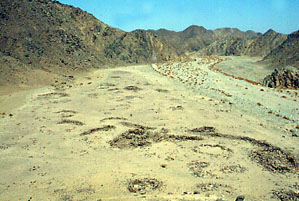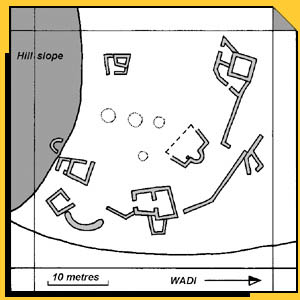|
An overview of ancient settlement Bir Handosi
looking east. A relatively modern Bedouin graveyard was discovered across
the wadi:
|
|
Plan of the part of Bir Handosi where the ancient
buildings have been remodeled in more recent times, probably by Bedouin herdsmen:
|
|
|
|
|

|
|

|
|
|
|
|
|
|
|
|
Objective of visit:
|
|
To draw a measured plan of
the site and study the surface remains (including the ceramic finds). |
|
Date of visit:
|
|
- June 1999 |
|
Fellow visitors:
|
|
Prof.Dr. Steve Sidebotham
(University of Delaware) and Faragallah (our Bedouin guide). |
| Results: |
|
A survey was performed using
the Global Positioning System, a theodolite and steel tape measures. Off-site
assistance was given by pottery expert Dr. Roberta Tomber (Museum of London).
No excavations took place. Our plans and description
were published in: S.E. Sidebotham, H. Barnard and G. Pyke; Five enigmatic
late Roman settlements in the Eastern Desert; Journal of Egyptian Archaeology 2002; vol. 88:
pp. 187-225. |
| Approximate position and date of the site: |
|
Bir Handosi in the southern
part of the Egyptian desert, between the Quft-Quseir and Edfu-Marsa Alam asphalt
roads. Surface pottery dated to the late Roman period (ca. 300 - 600
AD). |
| Short description of the site: |
|
Bir Handosi was settlement
of simple huts in a dead-end wadi, far from any ancient roads, mines or quarries.
Surface finds were limited to potsherds and a tombstone in Arabic which renders
the function of the settlement enigmatic. |
| Additional remarks: |
|
The reason for the existence
of Bir Handosi might have been the hunting or gathering of yet unknown commodities
or the temporary residence for political or religious refugees. At some point
in time, Islamic visitors (probably Bedouin herdsmen) remodeled some of the
ancient structures. There is a functioning well just west of the settlement
which was most likely also operational when Bir Handosi was inhabited. Our
work was sponsored by the University of Delaware and private donors. |
| HOME |
|
|

|
|
|
